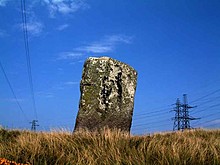|
|
|
|
Bwlch-y-DdeufaenStanding Stones
|
||||||||||||||||||||||||
|
|
|
Images (click to view fullsize) |
|






































|
Fieldnotes |
|
|
The two stones that give the pass its name are a big step up in size from the ankle biters of Cerrig Pryfaid. Both are taller than me, and there’s some serious girth going on too. The tapering southern stone is a beauty, Blossom and I struggle to reach round it with our combined outstretched arms. There’s a small, shallow drill hole on one side, as if someone foolishly attempted to convert this into a gatepost and was struck dead for their temerity before getting very far. I’ll leave Rhiannon to find some suitably doomy folkore to confirm the point. By contrast, the northern stone is flat-topped and appears to shine out its whiteness against the dark heather. On closer inspection, the whiteness is entirely illusory, the stone isn’t quartz at all but a light grey. There are two further, shorter uprights close to the northern stone, one of which is indeed a quartzy rock. Their placement isn’t obvious but reminds me somewhat of a scaled-up version of the little followers of Maen Mawr in South Wales. In amongst the chocks at the base of the northern stone is one very dark rock, a matt coal black in colour. It’s not clear whether this is a later addition as it doesn’t seem to be doing much chocking. We don’t realise that there’s a fan of much smaller uprights close to the southern stone, and in truth a visit in summer vegetation isn’t the best time to look for them. It is a great time to admire the purple flowers adorning the heather though. Once again, the setting is excellent. The views are similar to those from Cerrig Pryfaid, but with added elevation giving a fresh perspective to the outcrops of Pen y Castell. The stones are not set on the crest of the pass, so there’s no view northwards to speak of. Instead they turn their impassive faces resolutely southeast, looking down the valley of the Tafalog, heading off to join the great Afon Conwy three or four miles away. Surrounded now by pylons and cables, yet they retain their dignity against these huge, transitory metal giants. Time is on their side after all. I’m really taken with these stones. The sense of deep time seems to hang around them, from the ageless mountains, through the monument builders, the tramp of Roman soldiers, into a hinterland of iron and wire. Rather than detracting, the pylons add to this sense that we’re standing in the midst of a palimpsest, layers of time and people still there, just below the surface. And perhaps we’re a shadowy presence in earlier and later times, too. This post appears as part of the weblog entry Stone out of song – Bwlch y Ddeufaen and Maen y Bardd 9 July 2011
|
 Posted by thesweetcheat
Posted by thesweetcheat19th May 2015ce Edited 19th May 2015ce |
|
How can you talk about these stones without mentioning those blooming pylons, they are there, get over it, move on. The two big stones stand maybe 60-70 yards apart northwest - southeast of of each other. The north west stone is just over six feet tall and squarish with flat top. The southeast stone is about eight to nine feet tall roundish in section and pointy topped, I struggle to not to bring up male and female associations. Both stones have other numerous smaller stones in close attendance. I cant recall how many times I've been here, but it hasn't been this misty and damp before. We are wet and cold now so it's time to dry off and warm up whilst we drive over to Capel Garmon. |
 Posted by postman
Posted by postman23rd December 2012ce |
|
The east stone of "The Pass of the Two Stones" has a good number of ankle-high stones radiating outwards some distance to the east, in a dip. These are earthfast, and not here by coincidence. Frances Lynch in her guidebook to the ancient sites of the area, likens the small stones' to that of Bryn Cader Faner. I counted fourteen small stones here. There are likely more under the grass. The east menhir can be seen to the rear, as can the west menhir, with one of its other associated stones. Frances Lynch also says the western stone has a further two associated stones. |
 Posted by ShropshireTraveller
Posted by ShropshireTraveller17th June 2005ce |
| Here the stones are in competition with the ridiculous pylons. They win hands down. |
 Posted by IronMan
Posted by IronMan18th March 2002ce |
| The valley of the two stones - don't know how you say electricity pylons in Welsh! But somehow, if you make your way up here at the right time they just don't seem to matter. Winter is the best, preferably at twilight, this place just has such an atmosphere. The two huge standing stones stand on the horizon as you rise out of the valley to look down towards Anglesey (there's the remains of a Roman Road here) - and they almost seem like gateposts, the entrance to another world. I often wonder if that was their intended effect. |
Posted by iaing 8th November 2001ce |
Folklore |
|
An early telling of the tale. No mention of the hole. But you can apparently use the stones to judge the size of the giant.... there is a wide difference between [sepulchral] heaps, and those on the highest summits of these hills; the latter are formed of large building stones, the former chiefly of small stones, such as can be carried by hand;From Observations in the Snowdon Mountains by William Williams (1802). |
 Posted by Rhiannon
Posted by Rhiannon20th May 2015ce Edited 20th May 2015ce |

